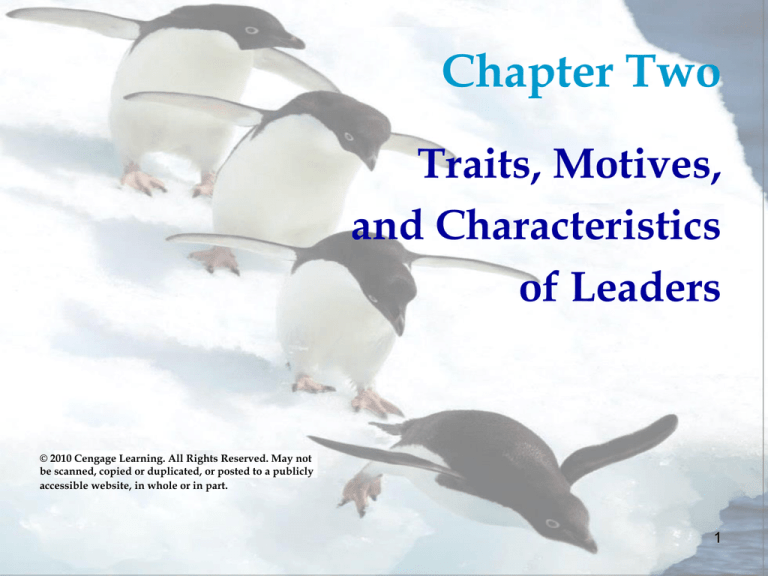
Chapter Two
Traits, Motives,
and Characteristics
of Leaders
© 2010 Cengage Learning. All Rights Reserved. May not
be scanned, copied or duplicated, or posted to a publicly
accessible website, in whole or in part.
1
Learning Objectives
Identify general and task-related traits
that contribute to leadership
effectiveness.
Describe how emotional intelligence
contributes to leadership effectiveness.
Identify key motives that contribute to
leadership effectiveness.
Describe cognitive factors associated with
leadership effectiveness.
© 2010 Cengage Learning. All Rights Reserved. May not be scanned, copied or
duplicated, or posted to a publicly accessible website, in whole or in part.
2
Learning Objectives (cont’d)
Discuss the heredity versus
environment issue in relation to
leadership effectiveness.
Summarize the strengths and
weaknesses of the trait approach to
leadership.
© 2010 Cengage Learning. All Rights Reserved. May not be scanned, copied or
duplicated, or posted to a publicly accessible website, in whole or in part.
3
Leadership Characteristics
1. Personality Traits
2. Leadership Motives and Needs
3. Cognitive Factors and Intelligence
© 2010 Cengage Learning. All Rights Reserved. May not be scanned, copied or
duplicated, or posted to a publicly accessible website, in whole or in part.
4
1. Personality Traits
General Personality Traits
Traits observable both within and
outside the context of work
Task-Related Personality Traits
Traits closely associated with task
accomplishment
© 2010 Cengage Learning. All Rights Reserved. May not be scanned, copied or
duplicated, or posted to a publicly accessible website, in whole or in part.
5
Figure 2-1 General Personality
Traits of Effective Leaders
© 2010 Cengage Learning. All Rights Reserved. May not be scanned, copied or
duplicated, or posted to a publicly accessible website, in whole or in part.
6
Figure 2-2 Task-Related
Personality Traits of Leaders
© 2010 Cengage Learning. All Rights Reserved. May not be scanned, copied or
duplicated, or posted to a publicly accessible website, in whole or in part.
7
2. Leadership Motives and Needs
Leaders have an intense desire to
occupy a position of responsibility
for others and to control them.
This desire is evident in four needs
or motives, all of which can be
considered task related.
© 2010 Cengage Learning. All Rights Reserved. May not be scanned, copied or
duplicated, or posted to a publicly accessible website, in whole or in part.
8
Figure 2-3 Leadership Motives
© 2010 Cengage Learning. All Rights Reserved. May not be scanned, copied or
duplicated, or posted to a publicly accessible website, in whole or in part.
9
3. Cognitive Factors
and Intelligence
Cognition refers to the mental process or
faculty by which knowledge is gathered
Leaders must have problem-solving and
intellectual skills to effectively gather,
process, and store essential information
Six cognitive factors related to leadership
effectiveness have been identified
© 2010 Cengage Learning. All Rights Reserved. May not be scanned, copied or
duplicated, or posted to a publicly accessible website, in whole or in part.
10
Figure 2-4 Cognitive Factors
and Leadership
© 2010 Cengage Learning. All Rights Reserved. May not be scanned, copied or
duplicated, or posted to a publicly accessible website, in whole or in part.
11
The WICS Model of Leadership in
Organizations
© 2010 Cengage Learning. All Rights Reserved. May not be scanned, copied or
duplicated, or posted to a publicly accessible website, in whole or in part.
12
The WICS Model (cont’d)
According to the WICS model, a
leader needs the following for the
successful utilization of intelligence:
Creative skills to generate new ideas
Analytical skills to evaluate whether
the ideas are good ones
Practical skills to implement the ideas
and to persuade others of their value.
© 2010 Cengage Learning. All Rights Reserved. May not be scanned, copied or
duplicated, or posted to a publicly accessible website, in whole or in part.
13
Influence of Heredity and
Environment
Are leaders born or are they made? Both.
Individuals inherit a basic capacity to
develop personality traits and mental
ability that sets an outer limit on how
extensively these traits can be developed
Environmental influences, in turn,
determine how much of an individual’s
potential will be developed
© 2010 Cengage Learning. All Rights Reserved. May not be scanned, copied or
duplicated, or posted to a publicly accessible website, in whole or in part.
14
Trait Approach
Strengths
Serves as a guide
to leader selection
Can guide
individuals in
preparing for
leadership
responsibility
Limitations
© 2010 Cengage Learning. All Rights Reserved. May not be scanned, copied or
duplicated, or posted to a publicly accessible website, in whole or in part.
Does not identify
which
characteristics are
absolutely needed
Does not specify
how much of a trait
or characteristic is
needed
Can breed an elitist
conception of
leadership
15
Summary
The trait-based perspective of leadership
asserts that certain personality traits,
leader motives, and cognitive factors
contribute to leadership effectiveness
Personality traits include both general
traits and task-related traits
Leaders can often be distinguished by
their needs or motives
© 2010 Cengage Learning. All Rights Reserved. May not be scanned, copied or
duplicated, or posted to a publicly accessible website, in whole or in part.
16
Summary (cont’d)
Cognitive ability is important for
leadership success
Traits, motives, and cognitive ability
derive from a combination of
heredity and environment
Traits do appear to distinguish
leaders from nonleaders and
effective leaders from less-effective
leaders
© 2010 Cengage Learning. All Rights Reserved. May not be scanned, copied or
duplicated, or posted to a publicly accessible website, in whole or in part.
17








